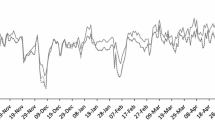Abstract
Three dry bean harvests are possible in some regions of Brazil that differ significantly in temperature, rainfall and day length conditions. Thus in breeding programs, generation advance using the bulk method can be carried out in these three periods. It is questionable whether under conditions such as these the action of natural selection would contribute to an increased frequency of individuals considered superior by breeders. The present study assessed six segregating populations, for up to 17 successive generations to check the effects of natural selection during inbreeding. Six populations were generated from a partial diallel: one group consisting of two early maturity cultivars, ESAL 686 and Manteigão Fosco was crossed to a second group of three cultivars with medium maturity, Carioca MG, Milionario and Ouro. The six populations plus the five parents were assessed in experiments using a randomized complete block design, in three locations: Lavras, where in breeding started from the F2 generation; Lambari and Patos de Minas, from the F3 generation. A linear regression equation was fitted to the parents and hybrids mean data in each location, considering grain yield as the dependent variable (y) and generations (F2 = 1, F3 = 2, etc.) as the independent variable. Genetic progress was estimated from the differences between the linear regression coefficients of the hybrids (bi)and the mean of the b coefficient of their respective parents (bj). The (bi-bj) were positive in all cases, showing that natural selection acted in all the segregating populations and contributed to an average increase in grain yield of 2.5% per generation over the mean of the parents.
Similar content being viewed by others
References
Abreu, A. de F.B., M.A.P. Ramalho, J.B. dos Santos & L.A. Martins, 1994. Progresso do melhoramento genético do feijoeiro nas décadas de setenta e oitenta nas regiões Sul e Alto Paranaiba em Minas Gerais. Pesquisa Agropecuária Brasileira 29: 105–112.
Abreu, A. de F.B., M.A.P. Ramalho, M.J.B. de Andrade & I.A. Pereira Filho, 1998. Estabilidade de linhagens de feijão em algumas localidades do Estado de Minas Gerais no periodo de 1994 a 1995. Ciência e Agrotecnologia 22: 308–312.
Allard, R.W., 1988. Genetic changes associated with the evolution of adaptedness in cultivated plants and their wild progenitors. J Heredity 79: 225–238.
Cardoso, A.A. & C. Vieira, 1976. Comportamento de duas misturas de seis variedades de feijão (Phaseolus vulgaris L.). Revista Ceres 23: 142–149.
Cardoso, A.A. & C. Vieira, 1971. Progressos nos estudos sobre misturas varietais de feijão (Phaseolus vulgaris L.). Revista Ceres 18: 465–477.
Cochran, W.G. & G.M. Cox, 1957. Experimental Designs. 2nd ed. John Wiley and Sons Inc., New York, pp. 611.
Fonseca Júnior, N. da S., 1997. Progresso genético na cultura do feijoeiro no estado do Paraná para o período de 1977 a 1995. Piracicaba: ESALQ, pp. 168. (Tese - Doutorado em genética e melhoramento de plantas).
Gomez, K.A. & A.A. Gomez, 1978. Statistical procedures for agricultural research. 2nd ed. J. Wiley, New York, pp. 679.
Gonçalves, F.M.A., 2000. Seleção natural em populações segregantes do feijoeiro. Lavras: UFLA, pp. 98. (Tese - Doutorado em genética e melhoramento de plantas).
Hamblin, J., 1977. Plant breeding interpretations of the effects of bulk breeding on four populations of beans (Phaseolus vulgaris L.). Euphytica 26: 157–168.
Hamblin, J. & J.R. Morton, 1977. Genetic interpretations of the effects of bulk breeding on four populations of beans (Phaseolus vulgaris L.). Euphytica 26: 75–83.
Kervella, J. & G. Fouilloux, 1992. A theoretical study of the bulk breeding method 1. Importance and consequences of losses due to sampling. Euphytica 60: 185–195.
Mishra, D.K., C.B. Singh & S.K. Rao, 1994. Effectiveness of different selection methods in segregating population of rice (O. sativa L.) in ARC 10372 × IR 36 in different enviroments. Ind J Genet 54: 402–408.
Raposo, F.V., 1999. Comparação de métodos de condução de populações segregantes na cultura do feijoeiro. Lavras: UFLA, pp. 73. (Dissertarção - Mestrado em Genética e Melhoramento de Plantas).
Singh, R.P., S. Rajaram, A. Miranda, J. Huerta-Espino & E. Autrique, 1998. Comparison of two crossing and four selection schemes for yield, yield traits, and slow rusting resistance to leaf rust in wheat. Euphytica 100: 35–43.
Author information
Authors and Affiliations
Rights and permissions
About this article
Cite this article
Corte, H.R., Patto Ramalhol, M.A., Avelar Gonçalves, F.M. et al. Natural selection for grain yield in dry bean populations bred by the bulk method. Euphytica 123, 387–393 (2002). https://doi.org/10.1023/A:1015065815131
Issue Date:
DOI: https://doi.org/10.1023/A:1015065815131



